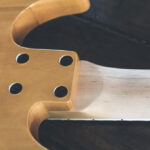Looking to expand your sonic palette and delve into deeper tones? The Baritone Electric Guitar might be the instrument you’ve been searching for. Bridging the gap between a standard guitar and a bass, the baritone guitar offers a unique sonic landscape that’s captivating musicians across genres. At GuitarPlayers.net, we’re excited to guide you through the essentials of this fascinating instrument.
What Defines a Baritone Electric Guitar?
The core difference between a standard electric guitar and a baritone electric guitar lies in its scale length. Scale length, the distance from the nut to the bridge, dictates string tension and overall pitch. While standard guitars typically feature a scale length around 25 inches, baritone guitars extend this to the 27-30 inch range. This increased length is crucial for achieving lower tunings comfortably and maintaining string tension.
To accommodate this longer scale, baritone electric guitars often feature slightly larger bodies and enhanced internal bracing. This construction ensures the instrument can handle the increased string tension and resonate effectively at lower frequencies. The extended scale length also impacts playability; the frets are spaced further apart, and you might find yourself experimenting with heavier gauge strings to achieve your desired feel and tone.
Alt text: A baritone electric guitar in sunburst finish is leaning against a vintage amplifier, showcasing its extended neck and body shape.
Diving into Baritone Guitar Tunings
While standard guitar tuning (E-A-D-G-B-E) is familiar, the baritone electric guitar truly shines when exploring lower registers. Common baritone tunings unlock a world of sonic possibilities:
- B-E-A-D-F#-B (Fourth Lower): Perhaps the most popular baritone tuning, this tuning is a perfect fourth lower than standard, offering a deep and resonant sound while retaining familiar intervals.
- B-E-A-D-G-B (Bass-Like): By substituting the F# with a G, this tuning mimics the lower five strings of a bass guitar, allowing guitarists to easily explore basslines and deeper rhythms.
- A-D-G-C-E-A (Fifth Lower): Taking the plunge a fifth lower than standard tuning, this option delivers incredibly deep and weighty tones, venturing into true bass territory.
These alternate tunings are not just about playing lower notes; they open up new harmonic possibilities and inspire different musical approaches.
The Allure of Baritone Guitar Versatility
The true magic of the baritone electric guitar lies in its remarkable versatility. It’s not just a one-trick pony for ultra-low riffs; it’s a dynamic instrument capable of enriching a wide range of musical styles.
Imagine seamlessly transitioning between lead guitar melodies, lush chord voicings, octave-lower harmonies, and even basslines – all within a single performance. The baritone electric guitar empowers you to do just that. Its deep, resonant tonal character adds a unique richness and depth to any musical texture. Expect full, powerful lows and a warm, pronounced lower-midrange that can fill sonic spaces beautifully.
From country and rock to metal, jazz, and even pop, the baritone electric guitar has found its place across genres. Its ability to provide both depth and clarity makes it a valuable tool for songwriters, composers, and performers seeking to expand their sonic horizons.
Alt text: Detailed view of a baritone electric guitar fretboard, emphasizing the wider fret spacing characteristic of baritone instruments.
Explore Baritone Electric Guitars at GuitarPlayers.net
Ready to explore the world of lower frequencies and unlock the potential of the baritone electric guitar? guitarplayers.net is your destination for discovering top brands and finding the perfect instrument to match your musical aspirations. Whether you’re seeking to add depth to your existing sound or embark on a new sonic adventure, the baritone guitar offers a rewarding and inspiring journey.

